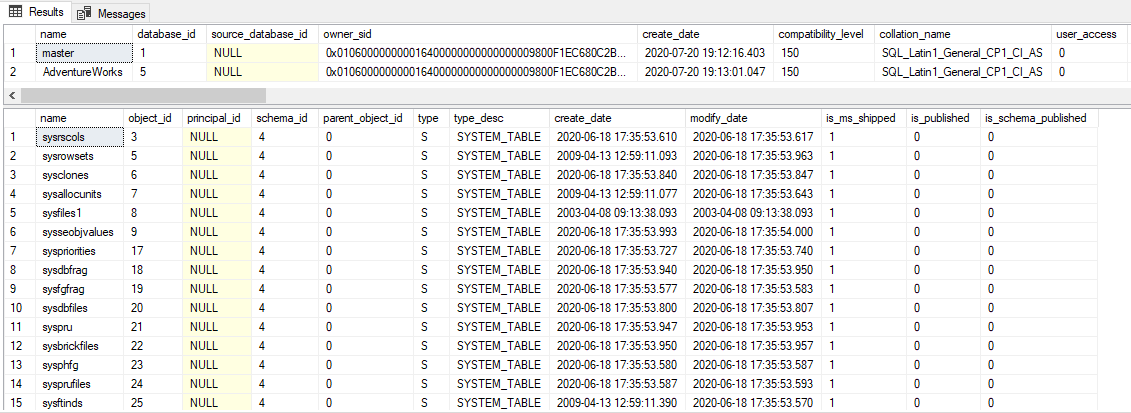Exercise - Verify Azure SQL Database
Now that you've seen how Azure SQL appears in SQL Server Management Studio (SSMS), you can verify the deployment.
Verify deployment
After you deploy an instance of SQL, you typically run queries to verify your deployment. In Azure SQL, some of these queries vary from SQL Server. In this step, you see what things change SQL Server, how they change, and what's new.
In this exercise, you walk through some common queries against system functions, dynamic management views (DMVs), and catalog views that you can use after deployment in SSMS. You see which ones work the same as SQL Server, which ones don't, and which ones are new to Azure SQL.
Connect to your Azure SQL Database logical server in SSMS if you haven't already.
Right-click the
AdventureWorksdatabase and select New Query.Check the version that you deployed by executing the well-known system function
@@VERSION.SELECT @@VERSION
The result looks a bit different from SQL Server. You can tell that this server is Azure SQL, which doesn't have versions. Azure SQL Database includes the most up-to-date changes in line with the latest release of SQL Server. However, using the system function
@@VERSIONis a common method to verify that you can "query" SQL Server.Determine the specific type of Azure SQL deployment, based on the number returned:
- 1: Personal or Desktop Engine
- 2: Standard
- 3: Enterprise
- 4: Express
- 5: SQL Database
- 6: SQL Data Warehouse
- 8: SQL Managed Instance
Run the following T-SQL command to see if you get the expected result.
SELECT SERVERPROPERTY('EngineEdition');
The result is 5, which makes sense because you deployed Azure SQL Database, not SQL Managed Instance or SQL Server Enterprise. There's no special number for SQL Server in Azure Virtual Machines. The number corresponds to the edition that you installed in the virtual machine. Personal or Desktop Engine is an earlier edition that's no longer used with SQL Server.
Examine the catalog views
sys.databasesandsys.objects. Typically, you look at these views to verify the installation and the status of system databases and to check system objects in your database.SELECT * FROM sys.databases; SELECT * FROM sys.objects;
In the first result set, the system databases
msdb,tempdb, andmodelaren't listed. Onlymasterand your user database are listed. Themasterdatabase in a logical server isn't the same as the physicalmasterdatabase installed with SQL Server. In Azure SQL Managed Instance, you see the normal set of system databases, as with any SQL Server instance.However,
sys.objectslooks similar to a normal SQL Server instance. That fact is true for system tables, internal tables, and user objects for the sampleAdventureWorksLTdatabase.Verify that all schedulers are online and that you're detecting the expected available CPUs, considering that you deployed with a two-vCore model.
SELECT * FROM sys.dm_os_schedulers where STATUS = 'VISIBLE ONLINE';
Two
VISIBLE ONLINEschedulers are what you'd expect when two vCores are available for the SQL Server instance where your SQL database is deployed.For a SQL Server deployment, you might normally look at DMVs like
sys.dm_process_memoryto see limits for CPU, memory, and workers. This DMV isn't supported with Azure SQL Database, because the user doesn't expose or control the details of the host that supports the database. You can use the DMVsys.dm_user_db_resource_governanceto review capacities and limits for your deployed SQL database. You can also usesys.dm_instance_resource_governancein Azure SQL Managed Instance.Run and review the following query results. Compare the results to your pricing tier and the limits documented for your deployed tier. The
slo_nameis the Service Level Objective (SLO) which states the deployment option, service tier, hardware, and compute amount. In addition, because Azure SQL Database uses Windows Job Objects for other resource limits, such as memory, you can use thesys.dm_os_job_objectDMV to see what resources are available for the deployment.SELECT * FROM sys.dm_user_db_resource_governance;
A common technique to look at a SQL Server deployment is to examine a list of active requests. Just like SQL Server, you can use
sys.dm_exec_requeststo view currently running SQL requests.SELECT * FROM sys.dm_exec_requests;
Using
sys.dm_exec_requestsfor Azure SQL Database is different from using it for SQL Server or SQL Managed Instance. This DMV shows only active requests related to your database, including background tasks or background tasks that don't have a database context that shows up asmaster. This behavior is because of the nature of an Azure SQL Database deployment.